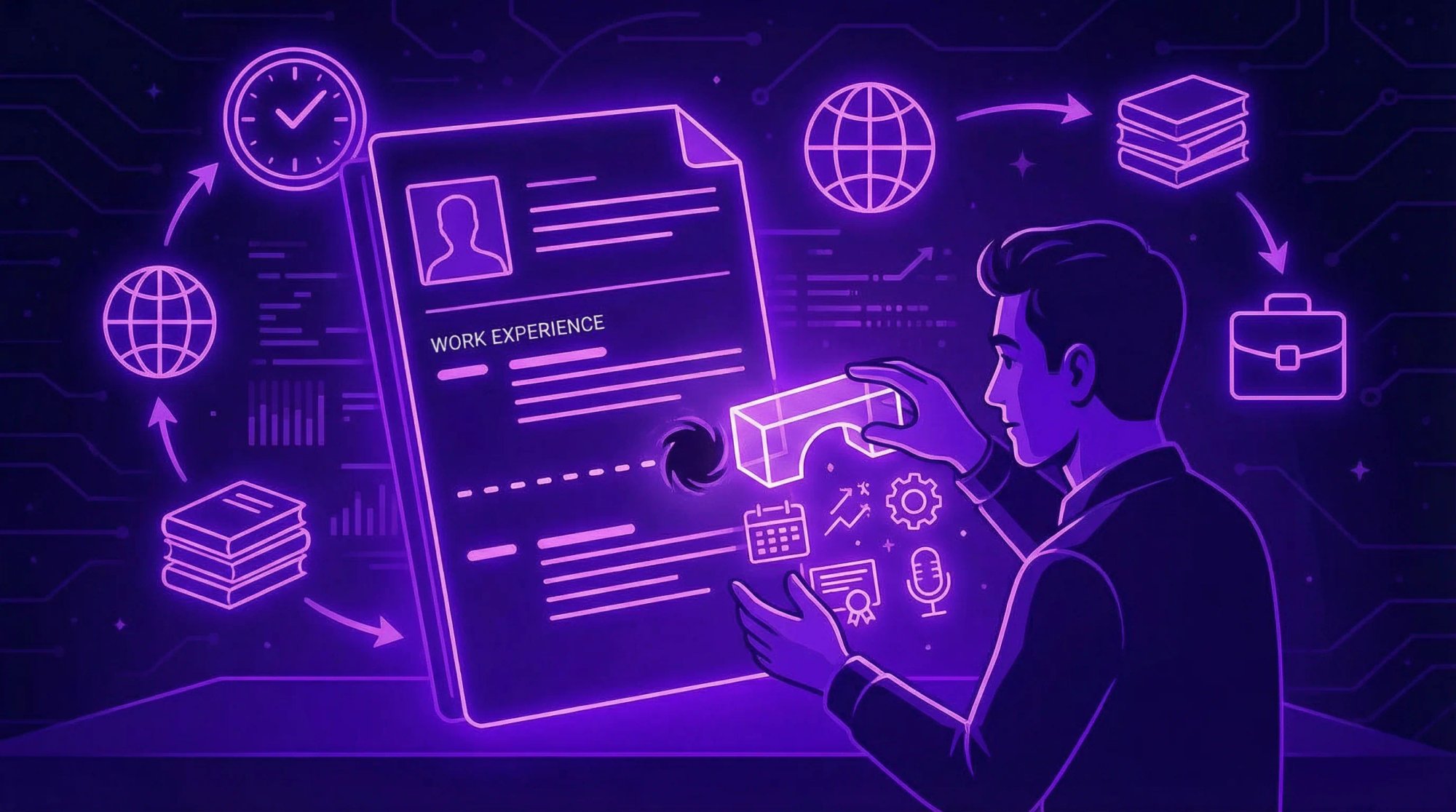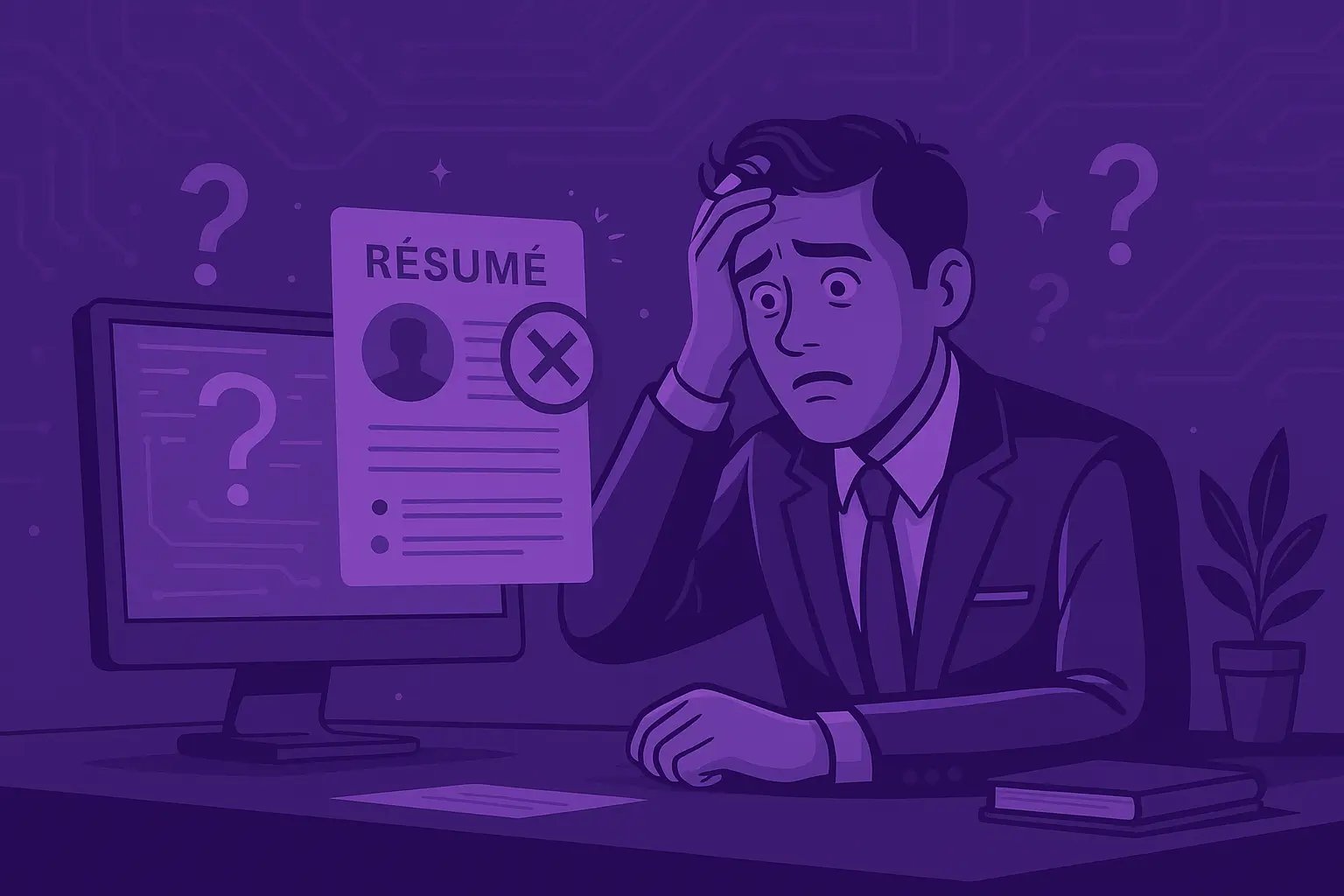Listing Experience On A Resume That Gets Hired

Here's a little secret about writing your resume's experience section: stop listing what you did and start showing what you accomplished.
It’s a simple shift in perspective, but it changes everything. Instead of just saying you were "responsible for social media," prove your value. Show them you "grew social media engagement by 45% in six months." See the difference? One is a passive list of tasks, the other is a powerful marketing statement that screams results.
Stop Listing Duties, Start Showing Impact
Let's be real—the old-school way of describing your job history is completely broken. In today's job market, just listing your daily responsibilities makes you look like every other applicant. Hiring managers and the software they use aren't looking for a generic job description; they're hunting for proof of your value.
The most critical mindset shift you can make is from duties to impact. A duty is what was expected of you. An impact is the tangible result you delivered. This isn't just good advice; it's essential for getting past the initial screening. An astonishing 75% of resumes are rejected by Applicant Tracking Systems (ATS) before a human ever lays eyes on them. These systems are programmed to find keywords and, more importantly, measurable results.
What Experience Matters Most?
Not all experience is created equal in the eyes of a recruiter. Knowing where to focus your energy can dramatically change how your resume is perceived.
This visual breaks down how recruiters typically weigh different types of experience:
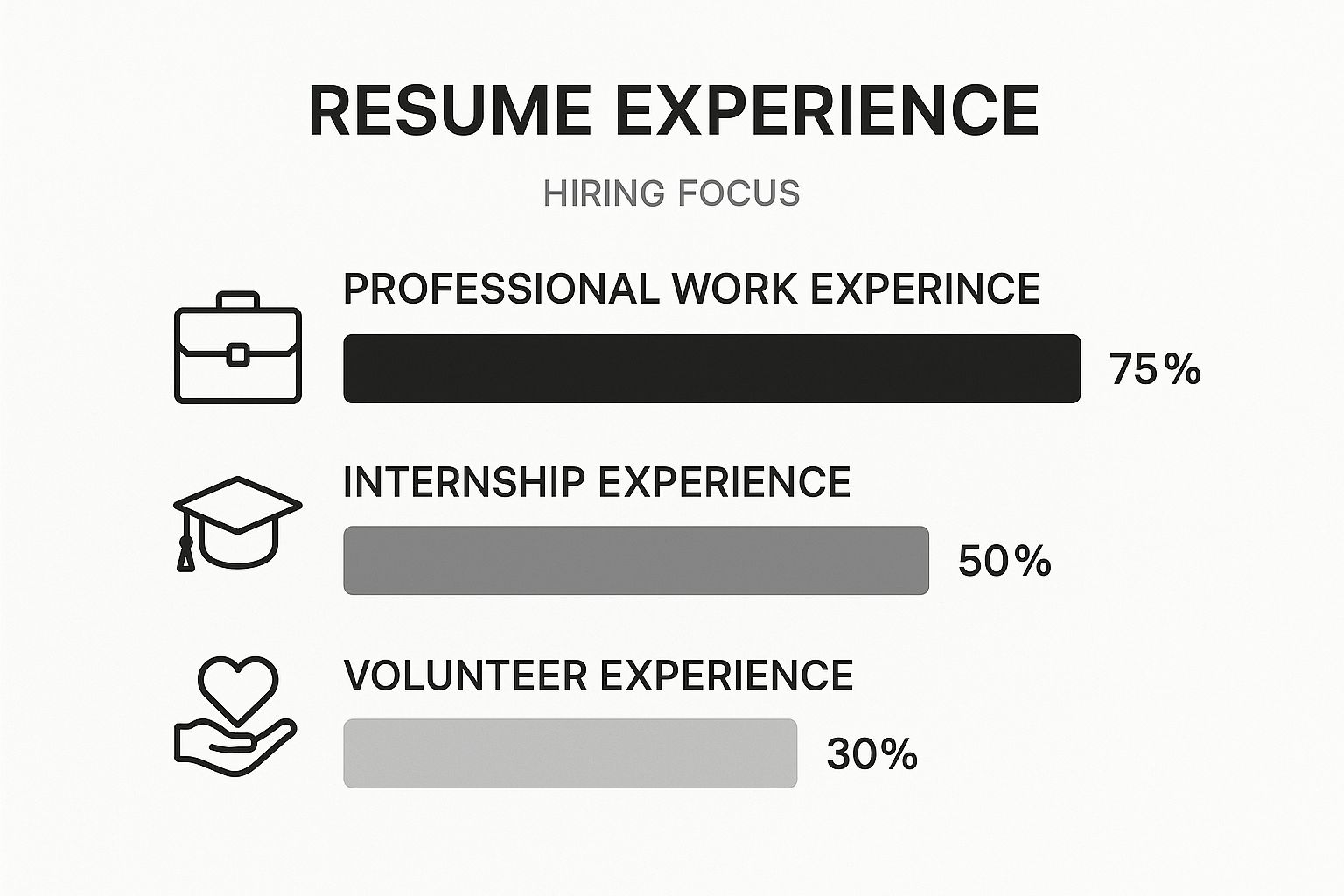
As you can see, professional work experience is king. But don't discount internships or even volunteer roles—if you frame them correctly, they can add serious weight to your application. The trick is to showcase relevant skills and achievements, no matter where you got them.
To truly make your resume pop, every single bullet point should answer the one question every recruiter is silently asking: "So what?"
The table below illustrates this transformation perfectly. We'll take a common, passive duty and rephrase it into a powerful, results-driven achievement that hiring managers love to see.
Before and After Resume Bullet Points
Notice how the "After" example is packed with action verbs, metrics, and a clear outcome. It doesn't just say what was done; it proves the value of doing it. This is the kind of detail that gets you noticed.
Your resume isn't just a record of your past; it's a strategic argument for your future. Each line should be a piece of evidence proving you can deliver results for your next employer.
When you focus on quantifiable achievements, you give them hard proof of what you're capable of. If you're struggling to find the right words, check out our guide packed with powerful professional achievements examples to help you reframe your own experiences for maximum impact.
Choosing the Right Format for Your Career Story
How you structure your resume isn't just a design choice—it's the first strategic move you make. Your career has a unique story, and the format you pick is what frames that narrative for a hiring manager who has only seconds to spare. The goal is to choose a layout that immediately highlights your biggest strengths.
Let's face it, the job market is incredibly crowded. In the United States alone, the number of applications per job has skyrocketed by about 182% since 2021. With that kind of volume, employers lean heavily on screening software just to keep up. Your format is your first line of defense, ensuring your resume speaks clearly to both a person and a machine. For more on this, check out the latest resume statistics on high5test.com.

There are really three core resume formats people use, and knowing which one works for your specific situation is the key to getting noticed.
The Chronological Format: Best for a Straight-Line Career
This is the classic, the one everyone knows. It lists your work history starting with your most recent job and working backward. Simple and effective.
- Who should use it? Professionals with a steady career path, especially if you've been climbing the ladder in the same industry. If you’re a project manager who’s earned a few promotions, this is your format.
- Why it works so well: It makes your career progression and loyalty crystal clear. Recruiters love it because it’s easy to scan and instantly understand your trajectory.
Honestly, this is the safest bet for most people. It lines up perfectly with what recruiters and Applicant Tracking Systems (ATS) are built to look for.
The Functional Format: Ideal for Career Changers and Gaps
The functional resume flips the script. Instead of focusing on where and when you worked, it puts the spotlight squarely on your skills. You group your experience under skill-based headings, not by employer.
- Who should use it? This is tailor-made for career changers, people with noticeable employment gaps, or anyone jumping back into the workforce after a break.
- Why it works so well: It allows you to showcase transferable skills that might otherwise get buried. Think about a marketer aiming for a tech role—they can highlight their expertise in data analysis and project management, making the lack of direct tech experience less of a hurdle.
A quick word of caution: While great for emphasizing skills, some old-school hiring managers can be wary of this format. It's a strategic choice, best used when your work timeline doesn't do your abilities justice.
The Hybrid Format: The Best of Both Worlds
Just like it sounds, the hybrid (or combination) format gives you a perfect mix. It kicks off with a powerful skills summary right at the top, then follows up with a streamlined chronological work history.
- Who should use it? It's a fantastic option for seasoned pros, freelancers, or anyone with a diverse skill set that’s still highly relevant to the job.
- Why it works so well: You get to grab the reader's attention immediately with your most important qualifications, while still giving them the clear timeline they expect. An executive, for example, could use this to spotlight leadership and strategy skills before diving into their impressive history of senior-level roles.
Picking the right format is a game-changer. If you want to dig deeper into optimizing your layout, our guide on https://aiapply.co/blog/resume-format-tips will walk you through everything you need to know to present your experience in the most compelling way.
Writing Bullet Points That Prove Your Value
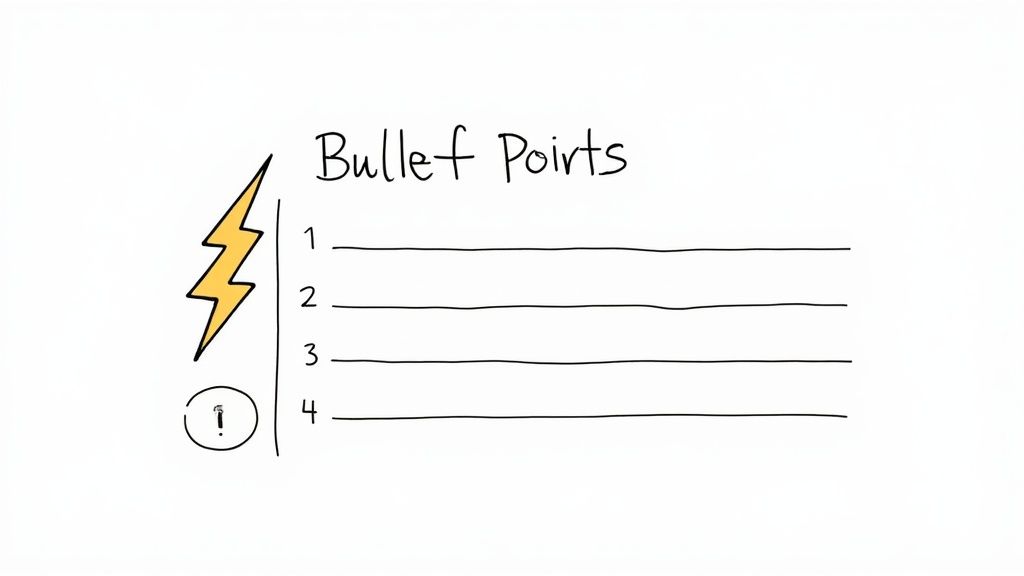
Okay, this is where the magic really happens. Vague phrases like "handled customer inquiries" or "managed team projects" are absolute resume killers. I’ve seen it a thousand times—they tell a hiring manager nothing and get your resume tossed in the 'no' pile.
To actually grab someone's attention, every single line in your experience section needs to be a hard-hitting testament to your value.
The secret I've seen work time and again is a simple but incredibly powerful formula. It’s what turns a boring, passive duty into a dynamic, active achievement. Think of it as your blueprint for every bullet point you write from now on.
The A-W-R Formula
I call it the A-W-R formula, and it’s super easy to remember: Action Verb + What You Did + Quantifiable Result. This structure is your best friend because it forces you to stop listing what you were supposed to do and start showcasing the real impact you made.
Let's break it down:
- Action Verb: Start with a punch. Ditch the tired, passive phrases like "responsible for" and swap them for dynamic verbs that scream ownership and initiative.
- What You Did: Get straight to the point. Briefly explain the project or task, and if you can, weave in keywords from the job description where they feel natural.
- Quantifiable Result: This is the game-changer. You have to add numbers to show the tangible impact of your work. How much money did you save? By what percentage did you boost efficiency? How many people did you train?
This isn't just about sounding impressive. It's about providing cold, hard proof that you deliver results. It directly answers the recruiter's unspoken question: "So what?"
Putting the Formula Into Practice
Seeing this formula in action is where the lightbulb really goes on. Let’s take a look at how you can transform a generic job duty into a compelling achievement that adds serious weight to your experience.
Example 1: Software Developer
- Before: Wrote code for a new mobile application feature.
- After: Architected and deployed a new in-app payment feature, resulting in a 15% reduction in checkout friction and a 10% increase in user conversions within the first quarter.
Example 2: Registered Nurse
- Before: Monitored patient vitals and administered medication.
- After: Implemented a new patient monitoring protocol that improved vital sign tracking accuracy, contributing to a 20% decrease in medication administration errors on the floor.
Example 3: Retail Manager
- Before: Was in charge of employee scheduling and training.
- After: Overhauled the weekly scheduling system using new software, which reduced scheduling conflicts by 90% and cut the time spent on administrative tasks by 5 hours per week.
See the difference? Each "After" example is specific, kicks off with a strong action verb, and gives a clear, measurable result. This is the kind of detail that makes a recruiter stop scrolling and actually start reading.
Think of each bullet point as a mini case study. You’re presenting an implied challenge, describing your action, and then proving the successful outcome with data. It tells a far more persuasive story than a simple laundry list of responsibilities ever could.
Find Your Numbers
I know what you're thinking—"I don't have numbers like that!" Quantifying your accomplishments can feel tricky, but the data is often closer than you think. And it doesn't always have to be about multi-million dollar deals.
Look for metrics in these areas:
- Time: Did you slash the time it took to complete a process? Did you deliver a project ahead of schedule?
- Volume: How many reports did you produce each week? How many clients were in your portfolio? How many articles did you publish a month?
- Money: Did you help increase revenue? Did you find a way to cut costs? Did you contribute to a successful grant application?
- Efficiency: By what percentage did you improve a workflow? Did you reduce errors or waste?
Even if you don't have the exact figures, a well-reasoned estimate can work just fine. Using phrases like "approximately," "over," or "more than" helps you frame your achievements accurately and honestly.
If you’re still feeling stuck, our comprehensive guide has dozens of powerful resume bullet point examples to get your ideas flowing. By sticking to this framework, you'll transform your resume from a boring work history into a compelling argument for why you're the one they need to hire.
Tailoring Your Resume Without Losing Your Mind
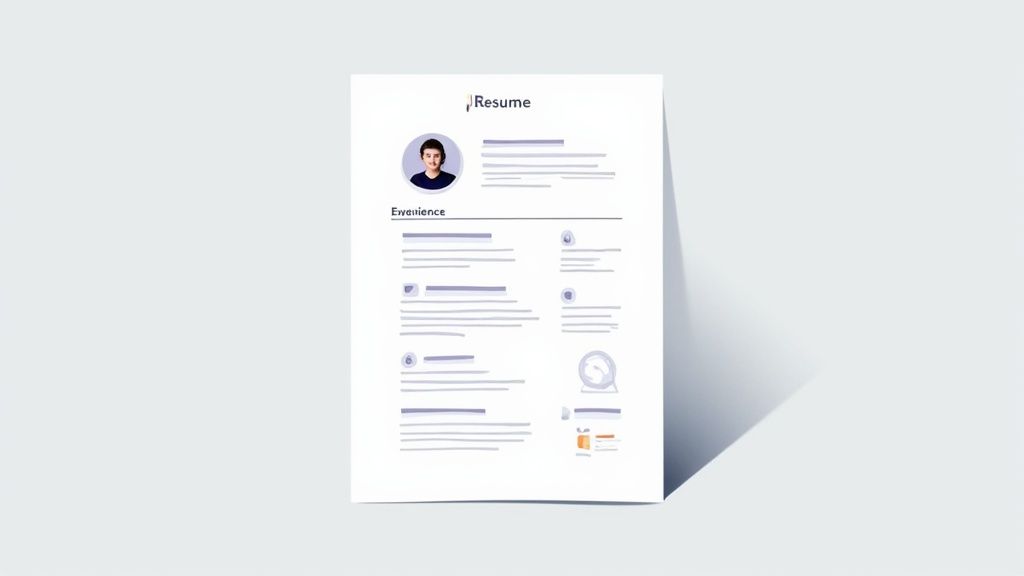
Let's be honest. Firing off the same generic resume to every job opening is the quickest way to land in the "no" pile. It screams that you haven't bothered to do your homework, and in today's market, that’s a killer mistake.
But the idea of rewriting your resume for every single application is exhausting, right? The good news is, you don’t have to. The secret is working smarter, not harder. It’s all about making small, strategic adjustments that show a hiring manager you’re the perfect fit for their specific needs.
Think of it like this: you wouldn't give the exact same sales pitch to every client. You’d highlight the features they care about most. Your resume is no different.
Decode the Job Description
Before you even think about editing your resume, you need to put on your detective hat. The job description isn't just a list of duties; it’s a treasure map. It’s packed with clues telling you precisely what the company is looking for and what keywords their screening software is trained to find.
Tear apart the "Responsibilities" and "Qualifications" sections. You’re hunting for two things:
- Keywords and Must-Have Skills: Look for words and phrases that pop up again and again. Are they obsessed with "SaaS sales," "agile methodology," or "revenue growth"? Those are your golden tickets.
- Company Culture Cues: How do they describe their team and their work? Do they use words like "fast-paced," "collaborative," or "data-driven"? Weaving this language into your resume creates an immediate connection.
Here's a pro tip: Don't just skim the job description—dissect it. I literally copy and paste the text into a separate document and use the highlighter tool on the most important phrases. It’s a simple trick that forces you to see what really matters to them.
Reorder and Refine Your Bullet Points
With your list of keywords and priorities in hand, it's time to perform some surgery on your work experience section. You're not changing your past; you're just shining a spotlight on the parts that matter most for this specific role.
Start by reordering your bullet points under each job. If the new role is all about client management, that accomplishment where you boosted client retention by 30% needs to be the very first bullet point they see. The less relevant achievements can be moved down the list or even removed for this version of your resume.
Next, it’s about refining your language. Swap your words for theirs. Maybe your resume says you "managed a team," but the job description repeatedly asks for someone who can "mentor junior staff." A simple tweak to "Mentored a team of four junior developers..." makes an instant impact.
This focused approach is incredibly powerful. It means that within the first few seconds of scanning your resume, the recruiter sees a candidate who has already solved the exact problems they’re facing. For a complete playbook on this, check out our deep-dive guide on how to tailor your resume to the job description. A few minutes of this targeted effort can be the difference between getting ignored and getting the interview.
Handling Gaps and Other Career Challenges
Let's be honest, almost no one has a perfectly linear career path. Life happens. Layoffs, taking time off to care for family, or deciding to switch fields entirely can leave you with a work history that feels… messy.
But these aren't red flags. They're part of your story. The trick is to stop seeing them as liabilities and start framing them with confidence. A gap in employment doesn’t have to be a weakness; it’s a chapter you get to write yourself.
Framing Your Employment Gaps
The worst thing you can do with an employment gap is try to hide it. That just makes it look suspicious. Instead, get out in front of it and show that you were proactive, even when you weren't in a traditional role. You want to shift the hiring manager's thinking from, "Why weren't you working?" to, "Wow, look what they did with that time."
Here are a few ways to fill that space constructively:
- Highlight Skill Development: Did you dive into online courses on Coursera or earn a new certification? Frame it as a strategic upskilling period.
- Showcase Project Work: Even small freelance gigs or consulting projects show you were keeping your skills sharp and staying engaged in your industry.
- Emphasize Volunteer Experience: Meaningful volunteer roles often involve serious project management, leadership, and teamwork—all skills that translate directly to the workplace.
This approach proves you’re not someone who just waits for things to happen. You make them happen.
Navigating a Career Change
Pivoting to a new career is one of the toughest challenges to articulate on a resume. At first glance, your past experience might feel totally unrelated. Your job is to be the bridge that connects your old roles to your new ambition.
Your resume’s summary or objective section is your best friend during a career pivot. Use it to state your new goal clearly and immediately call out 3-4 transferable skills that make you a perfect fit.
This sets the stage right away, so the recruiter isn't left trying to guess why you're applying. You're not starting from zero; you're bringing a unique blend of experiences from another field. For a deeper dive, our guide on how to pivot careers has more strategies for telling this story effectively.
Remember, the way resumes get read is changing. By 2025, an estimated 83% of companies will use AI to screen applicants, and 90% of hiring managers now actually encourage candidates to use AI resume builders. This means showcasing relevant skills in a clear, compelling way is more critical than ever. You can learn more about these trends and discover insights about resume statistics on enhancv.com.
When you address challenges head-on, you show you're not just qualified—you're resilient. And in today's world, that's a superpower.
Answering Your Toughest Resume Experience Questions
Even after you've nailed down your key accomplishments, a few tricky questions always seem to pop up when you’re putting together the experience section. These are the little details that can make you hesitate right before you click "apply."
Let's get those sorted out so you can send your resume with total confidence.
How Far Back Should a Resume Go?
I get this question all the time. The truth is, there's no single magic number, but a great rule of thumb is relevance over recency.
For most people, sticking to the last 10-15 years is the sweet spot. This window usually captures your most impressive and relevant career moves without making the recruiter scroll for days.
But what if you have a killer, super-relevant job from 16 years ago? Don't just leave it off. You can add a brief section at the bottom called "Prior Relevant Experience" and just list the company, title, and dates. This shows the depth of your experience without cluttering the main event.
Your resume is a marketing tool, not your complete autobiography. You're in the driver's seat. Your job is to tell a story that sells you for the position you want today, not the one you had two decades ago.
Should I Put Jobs on My Resume That Are Not Relevant?
Ah, the classic dilemma of the college-era retail job or that short-term gig waiting tables. Whether to include it really comes down to where you are in your career.
- If you're new to the workforce or a recent grad: Yes, definitely! That job taught you valuable soft skills. Think customer service, handling pressure, and time management. Your task is to frame your bullet points to highlight those transferable skills.
- If you're an experienced professional: It’s probably best to leave it off. With a decade of solid experience in your field, that unrelated job is just eating up precious space. The only time I’d reconsider is if it shows off a specific, unique skill that the job description happens to call for.
Think of your resume as a premium piece of real estate. Every single line has to earn its place by adding clear value. If an old job doesn't strengthen your pitch, it’s time to let it go.
How to Show a Promotion on a Resume?
Showcasing promotions is huge—it’s a clear signal of your growth, loyalty, and high performance. The key is to avoid making it look like you were job-hopping. Don't create a separate entry for each role at the same company.
Instead, group all your roles under one company heading. It's clean, effective, and tells a much better story.
Here's how I recommend formatting it:
TechSolutions Inc. | Austin, TX | 2018 – Present
Senior Software Engineer (June 2021 – Present)
- Led a team of four developers to launch the flagship Project Phoenix, delivering the project 15% ahead of schedule.
- Architected a new API that boosted data processing speeds by a massive 40%.
Software Engineer (May 2018 – June 2021)
- Developed and maintained core features for the company's main SaaS product.
- Contributed to a major code refactoring project that cut bug reports by 25%.
This layout makes your career progression impossible to miss. Any recruiter can see your upward momentum in a single glance.
Ready to stop worrying about formatting and focus on landing interviews? The AIApply platform can help you craft a perfectly tailored resume that highlights your promotions, skills, and unique career story. Stop guessing and start applying with confidence at https://aiapply.co.
Here's a little secret about writing your resume's experience section: stop listing what you did and start showing what you accomplished.
It’s a simple shift in perspective, but it changes everything. Instead of just saying you were "responsible for social media," prove your value. Show them you "grew social media engagement by 45% in six months." See the difference? One is a passive list of tasks, the other is a powerful marketing statement that screams results.
Stop Listing Duties, Start Showing Impact
Let's be real—the old-school way of describing your job history is completely broken. In today's job market, just listing your daily responsibilities makes you look like every other applicant. Hiring managers and the software they use aren't looking for a generic job description; they're hunting for proof of your value.
The most critical mindset shift you can make is from duties to impact. A duty is what was expected of you. An impact is the tangible result you delivered. This isn't just good advice; it's essential for getting past the initial screening. An astonishing 75% of resumes are rejected by Applicant Tracking Systems (ATS) before a human ever lays eyes on them. These systems are programmed to find keywords and, more importantly, measurable results.
What Experience Matters Most?
Not all experience is created equal in the eyes of a recruiter. Knowing where to focus your energy can dramatically change how your resume is perceived.
This visual breaks down how recruiters typically weigh different types of experience:

As you can see, professional work experience is king. But don't discount internships or even volunteer roles—if you frame them correctly, they can add serious weight to your application. The trick is to showcase relevant skills and achievements, no matter where you got them.
To truly make your resume pop, every single bullet point should answer the one question every recruiter is silently asking: "So what?"
The table below illustrates this transformation perfectly. We'll take a common, passive duty and rephrase it into a powerful, results-driven achievement that hiring managers love to see.
Before and After Resume Bullet Points
Notice how the "After" example is packed with action verbs, metrics, and a clear outcome. It doesn't just say what was done; it proves the value of doing it. This is the kind of detail that gets you noticed.
Your resume isn't just a record of your past; it's a strategic argument for your future. Each line should be a piece of evidence proving you can deliver results for your next employer.
When you focus on quantifiable achievements, you give them hard proof of what you're capable of. If you're struggling to find the right words, check out our guide packed with powerful professional achievements examples to help you reframe your own experiences for maximum impact.
Choosing the Right Format for Your Career Story
How you structure your resume isn't just a design choice—it's the first strategic move you make. Your career has a unique story, and the format you pick is what frames that narrative for a hiring manager who has only seconds to spare. The goal is to choose a layout that immediately highlights your biggest strengths.
Let's face it, the job market is incredibly crowded. In the United States alone, the number of applications per job has skyrocketed by about 182% since 2021. With that kind of volume, employers lean heavily on screening software just to keep up. Your format is your first line of defense, ensuring your resume speaks clearly to both a person and a machine. For more on this, check out the latest resume statistics on high5test.com.

There are really three core resume formats people use, and knowing which one works for your specific situation is the key to getting noticed.
The Chronological Format: Best for a Straight-Line Career
This is the classic, the one everyone knows. It lists your work history starting with your most recent job and working backward. Simple and effective.
- Who should use it? Professionals with a steady career path, especially if you've been climbing the ladder in the same industry. If you’re a project manager who’s earned a few promotions, this is your format.
- Why it works so well: It makes your career progression and loyalty crystal clear. Recruiters love it because it’s easy to scan and instantly understand your trajectory.
Honestly, this is the safest bet for most people. It lines up perfectly with what recruiters and Applicant Tracking Systems (ATS) are built to look for.
The Functional Format: Ideal for Career Changers and Gaps
The functional resume flips the script. Instead of focusing on where and when you worked, it puts the spotlight squarely on your skills. You group your experience under skill-based headings, not by employer.
- Who should use it? This is tailor-made for career changers, people with noticeable employment gaps, or anyone jumping back into the workforce after a break.
- Why it works so well: It allows you to showcase transferable skills that might otherwise get buried. Think about a marketer aiming for a tech role—they can highlight their expertise in data analysis and project management, making the lack of direct tech experience less of a hurdle.
A quick word of caution: While great for emphasizing skills, some old-school hiring managers can be wary of this format. It's a strategic choice, best used when your work timeline doesn't do your abilities justice.
The Hybrid Format: The Best of Both Worlds
Just like it sounds, the hybrid (or combination) format gives you a perfect mix. It kicks off with a powerful skills summary right at the top, then follows up with a streamlined chronological work history.
- Who should use it? It's a fantastic option for seasoned pros, freelancers, or anyone with a diverse skill set that’s still highly relevant to the job.
- Why it works so well: You get to grab the reader's attention immediately with your most important qualifications, while still giving them the clear timeline they expect. An executive, for example, could use this to spotlight leadership and strategy skills before diving into their impressive history of senior-level roles.
Picking the right format is a game-changer. If you want to dig deeper into optimizing your layout, our guide on https://aiapply.co/blog/resume-format-tips will walk you through everything you need to know to present your experience in the most compelling way.
Writing Bullet Points That Prove Your Value

Okay, this is where the magic really happens. Vague phrases like "handled customer inquiries" or "managed team projects" are absolute resume killers. I’ve seen it a thousand times—they tell a hiring manager nothing and get your resume tossed in the 'no' pile.
To actually grab someone's attention, every single line in your experience section needs to be a hard-hitting testament to your value.
The secret I've seen work time and again is a simple but incredibly powerful formula. It’s what turns a boring, passive duty into a dynamic, active achievement. Think of it as your blueprint for every bullet point you write from now on.
The A-W-R Formula
I call it the A-W-R formula, and it’s super easy to remember: Action Verb + What You Did + Quantifiable Result. This structure is your best friend because it forces you to stop listing what you were supposed to do and start showcasing the real impact you made.
Let's break it down:
- Action Verb: Start with a punch. Ditch the tired, passive phrases like "responsible for" and swap them for dynamic verbs that scream ownership and initiative.
- What You Did: Get straight to the point. Briefly explain the project or task, and if you can, weave in keywords from the job description where they feel natural.
- Quantifiable Result: This is the game-changer. You have to add numbers to show the tangible impact of your work. How much money did you save? By what percentage did you boost efficiency? How many people did you train?
This isn't just about sounding impressive. It's about providing cold, hard proof that you deliver results. It directly answers the recruiter's unspoken question: "So what?"
Putting the Formula Into Practice
Seeing this formula in action is where the lightbulb really goes on. Let’s take a look at how you can transform a generic job duty into a compelling achievement that adds serious weight to your experience.
Example 1: Software Developer
- Before: Wrote code for a new mobile application feature.
- After: Architected and deployed a new in-app payment feature, resulting in a 15% reduction in checkout friction and a 10% increase in user conversions within the first quarter.
Example 2: Registered Nurse
- Before: Monitored patient vitals and administered medication.
- After: Implemented a new patient monitoring protocol that improved vital sign tracking accuracy, contributing to a 20% decrease in medication administration errors on the floor.
Example 3: Retail Manager
- Before: Was in charge of employee scheduling and training.
- After: Overhauled the weekly scheduling system using new software, which reduced scheduling conflicts by 90% and cut the time spent on administrative tasks by 5 hours per week.
See the difference? Each "After" example is specific, kicks off with a strong action verb, and gives a clear, measurable result. This is the kind of detail that makes a recruiter stop scrolling and actually start reading.
Think of each bullet point as a mini case study. You’re presenting an implied challenge, describing your action, and then proving the successful outcome with data. It tells a far more persuasive story than a simple laundry list of responsibilities ever could.
Find Your Numbers
I know what you're thinking—"I don't have numbers like that!" Quantifying your accomplishments can feel tricky, but the data is often closer than you think. And it doesn't always have to be about multi-million dollar deals.
Look for metrics in these areas:
- Time: Did you slash the time it took to complete a process? Did you deliver a project ahead of schedule?
- Volume: How many reports did you produce each week? How many clients were in your portfolio? How many articles did you publish a month?
- Money: Did you help increase revenue? Did you find a way to cut costs? Did you contribute to a successful grant application?
- Efficiency: By what percentage did you improve a workflow? Did you reduce errors or waste?
Even if you don't have the exact figures, a well-reasoned estimate can work just fine. Using phrases like "approximately," "over," or "more than" helps you frame your achievements accurately and honestly.
If you’re still feeling stuck, our comprehensive guide has dozens of powerful resume bullet point examples to get your ideas flowing. By sticking to this framework, you'll transform your resume from a boring work history into a compelling argument for why you're the one they need to hire.
Tailoring Your Resume Without Losing Your Mind

Let's be honest. Firing off the same generic resume to every job opening is the quickest way to land in the "no" pile. It screams that you haven't bothered to do your homework, and in today's market, that’s a killer mistake.
But the idea of rewriting your resume for every single application is exhausting, right? The good news is, you don’t have to. The secret is working smarter, not harder. It’s all about making small, strategic adjustments that show a hiring manager you’re the perfect fit for their specific needs.
Think of it like this: you wouldn't give the exact same sales pitch to every client. You’d highlight the features they care about most. Your resume is no different.
Decode the Job Description
Before you even think about editing your resume, you need to put on your detective hat. The job description isn't just a list of duties; it’s a treasure map. It’s packed with clues telling you precisely what the company is looking for and what keywords their screening software is trained to find.
Tear apart the "Responsibilities" and "Qualifications" sections. You’re hunting for two things:
- Keywords and Must-Have Skills: Look for words and phrases that pop up again and again. Are they obsessed with "SaaS sales," "agile methodology," or "revenue growth"? Those are your golden tickets.
- Company Culture Cues: How do they describe their team and their work? Do they use words like "fast-paced," "collaborative," or "data-driven"? Weaving this language into your resume creates an immediate connection.
Here's a pro tip: Don't just skim the job description—dissect it. I literally copy and paste the text into a separate document and use the highlighter tool on the most important phrases. It’s a simple trick that forces you to see what really matters to them.
Reorder and Refine Your Bullet Points
With your list of keywords and priorities in hand, it's time to perform some surgery on your work experience section. You're not changing your past; you're just shining a spotlight on the parts that matter most for this specific role.
Start by reordering your bullet points under each job. If the new role is all about client management, that accomplishment where you boosted client retention by 30% needs to be the very first bullet point they see. The less relevant achievements can be moved down the list or even removed for this version of your resume.
Next, it’s about refining your language. Swap your words for theirs. Maybe your resume says you "managed a team," but the job description repeatedly asks for someone who can "mentor junior staff." A simple tweak to "Mentored a team of four junior developers..." makes an instant impact.
This focused approach is incredibly powerful. It means that within the first few seconds of scanning your resume, the recruiter sees a candidate who has already solved the exact problems they’re facing. For a complete playbook on this, check out our deep-dive guide on how to tailor your resume to the job description. A few minutes of this targeted effort can be the difference between getting ignored and getting the interview.
Handling Gaps and Other Career Challenges
Let's be honest, almost no one has a perfectly linear career path. Life happens. Layoffs, taking time off to care for family, or deciding to switch fields entirely can leave you with a work history that feels… messy.
But these aren't red flags. They're part of your story. The trick is to stop seeing them as liabilities and start framing them with confidence. A gap in employment doesn’t have to be a weakness; it’s a chapter you get to write yourself.
Framing Your Employment Gaps
The worst thing you can do with an employment gap is try to hide it. That just makes it look suspicious. Instead, get out in front of it and show that you were proactive, even when you weren't in a traditional role. You want to shift the hiring manager's thinking from, "Why weren't you working?" to, "Wow, look what they did with that time."
Here are a few ways to fill that space constructively:
- Highlight Skill Development: Did you dive into online courses on Coursera or earn a new certification? Frame it as a strategic upskilling period.
- Showcase Project Work: Even small freelance gigs or consulting projects show you were keeping your skills sharp and staying engaged in your industry.
- Emphasize Volunteer Experience: Meaningful volunteer roles often involve serious project management, leadership, and teamwork—all skills that translate directly to the workplace.
This approach proves you’re not someone who just waits for things to happen. You make them happen.
Navigating a Career Change
Pivoting to a new career is one of the toughest challenges to articulate on a resume. At first glance, your past experience might feel totally unrelated. Your job is to be the bridge that connects your old roles to your new ambition.
Your resume’s summary or objective section is your best friend during a career pivot. Use it to state your new goal clearly and immediately call out 3-4 transferable skills that make you a perfect fit.
This sets the stage right away, so the recruiter isn't left trying to guess why you're applying. You're not starting from zero; you're bringing a unique blend of experiences from another field. For a deeper dive, our guide on how to pivot careers has more strategies for telling this story effectively.
Remember, the way resumes get read is changing. By 2025, an estimated 83% of companies will use AI to screen applicants, and 90% of hiring managers now actually encourage candidates to use AI resume builders. This means showcasing relevant skills in a clear, compelling way is more critical than ever. You can learn more about these trends and discover insights about resume statistics on enhancv.com.
When you address challenges head-on, you show you're not just qualified—you're resilient. And in today's world, that's a superpower.
Answering Your Toughest Resume Experience Questions
Even after you've nailed down your key accomplishments, a few tricky questions always seem to pop up when you’re putting together the experience section. These are the little details that can make you hesitate right before you click "apply."
Let's get those sorted out so you can send your resume with total confidence.
How Far Back Should a Resume Go?
I get this question all the time. The truth is, there's no single magic number, but a great rule of thumb is relevance over recency.
For most people, sticking to the last 10-15 years is the sweet spot. This window usually captures your most impressive and relevant career moves without making the recruiter scroll for days.
But what if you have a killer, super-relevant job from 16 years ago? Don't just leave it off. You can add a brief section at the bottom called "Prior Relevant Experience" and just list the company, title, and dates. This shows the depth of your experience without cluttering the main event.
Your resume is a marketing tool, not your complete autobiography. You're in the driver's seat. Your job is to tell a story that sells you for the position you want today, not the one you had two decades ago.
Should I Put Jobs on My Resume That Are Not Relevant?
Ah, the classic dilemma of the college-era retail job or that short-term gig waiting tables. Whether to include it really comes down to where you are in your career.
- If you're new to the workforce or a recent grad: Yes, definitely! That job taught you valuable soft skills. Think customer service, handling pressure, and time management. Your task is to frame your bullet points to highlight those transferable skills.
- If you're an experienced professional: It’s probably best to leave it off. With a decade of solid experience in your field, that unrelated job is just eating up precious space. The only time I’d reconsider is if it shows off a specific, unique skill that the job description happens to call for.
Think of your resume as a premium piece of real estate. Every single line has to earn its place by adding clear value. If an old job doesn't strengthen your pitch, it’s time to let it go.
How to Show a Promotion on a Resume?
Showcasing promotions is huge—it’s a clear signal of your growth, loyalty, and high performance. The key is to avoid making it look like you were job-hopping. Don't create a separate entry for each role at the same company.
Instead, group all your roles under one company heading. It's clean, effective, and tells a much better story.
Here's how I recommend formatting it:
TechSolutions Inc. | Austin, TX | 2018 – Present
Senior Software Engineer (June 2021 – Present)
- Led a team of four developers to launch the flagship Project Phoenix, delivering the project 15% ahead of schedule.
- Architected a new API that boosted data processing speeds by a massive 40%.
Software Engineer (May 2018 – June 2021)
- Developed and maintained core features for the company's main SaaS product.
- Contributed to a major code refactoring project that cut bug reports by 25%.
This layout makes your career progression impossible to miss. Any recruiter can see your upward momentum in a single glance.
Ready to stop worrying about formatting and focus on landing interviews? The AIApply platform can help you craft a perfectly tailored resume that highlights your promotions, skills, and unique career story. Stop guessing and start applying with confidence at https://aiapply.co.
Don't miss out on
your next opportunity.
Create and send applications in seconds, not hours.






